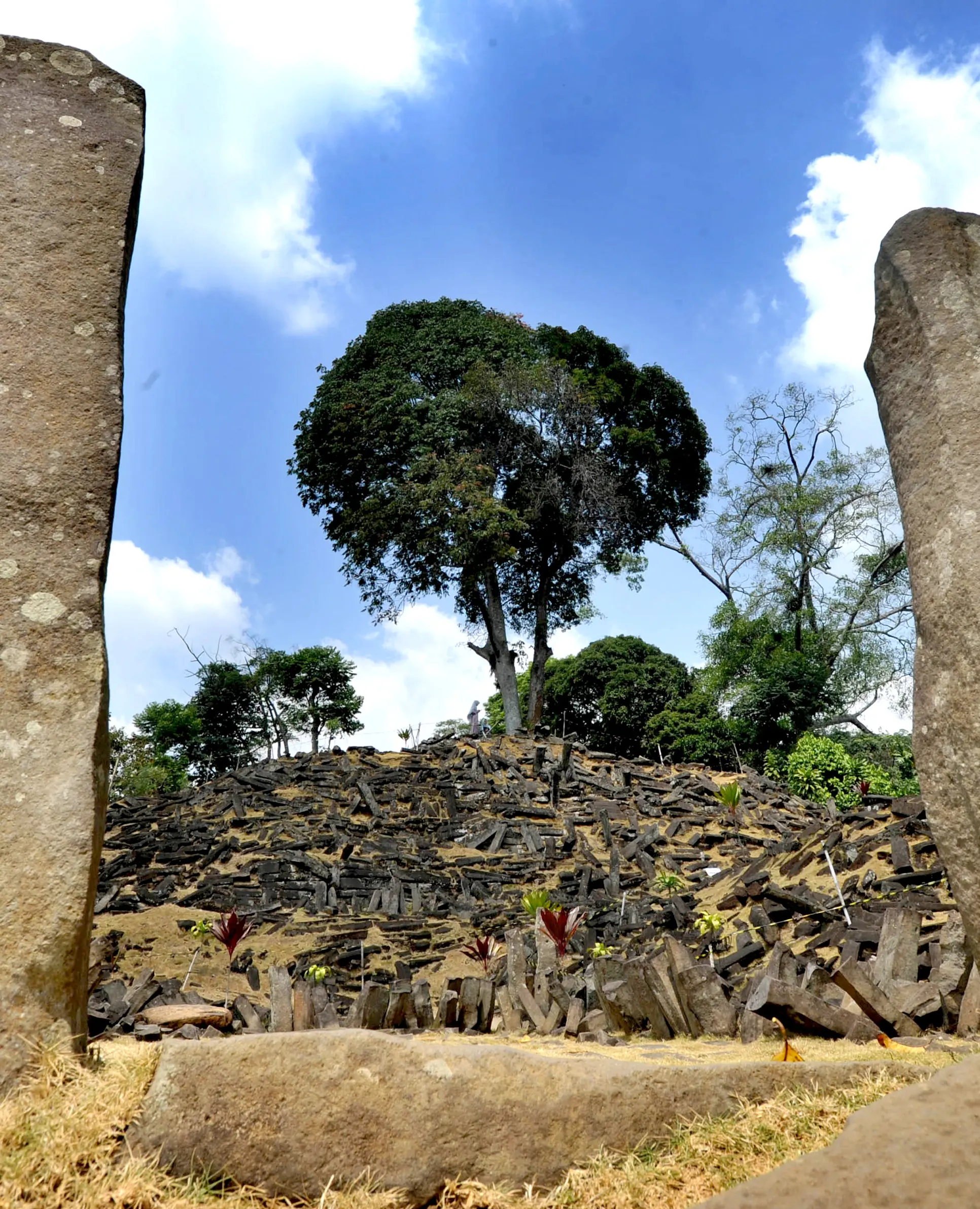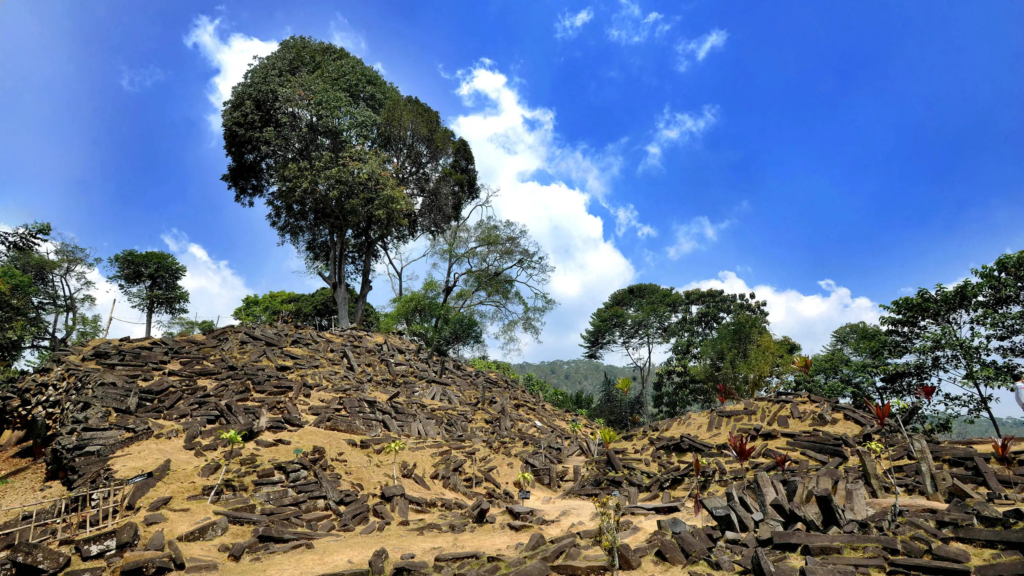Introduction
Gunung Padang, situated in West Java, Indonesia, has become a focal point of archaeological curiosity and controversy. This ancient megalithic site, often referred to as a pyramid, challenges conventional historical narratives and opens doors to new perspectives on human civilization. Its enigmatic structure, layered history, and the ongoing debates surrounding its purpose have fuelled both scholarly and public interest. In this essay, we will delve into the history of Gunung Padang, exploring its archaeological significance and contemplating the various theories regarding its possible uses.
History
Gunung Padang is perched atop a hill in the Cianjur Regency, approximately 50 kilometres southwest of Bandung. Initially, it was perceived as a natural hill until investigations in the late 19th century unveiled the existence of a massive structure underneath the layers of earth and vegetation. Dutch geologist R. Van Bemmelen was the first to document the site in 1914, drawing attention to its peculiar terraced formations. However, it wasn’t until the late 20th century that more comprehensive research and excavations were initiated.
Archaeological findings reveal that Gunung Padang’s origins date back to at least 4,000 years, making it potentially older than Egypt’s Giza pyramids. The site consists of several terraces built on top of one another, with the first terrace being the most extensively studied. Initial radiocarbon dating suggested the uppermost layer could be around 3,000 to 3,500 years old, while deeper layers could potentially reach back to 20,000 years. This timeline has stirred considerable debate, with some scholars questioning the accuracy of dating methods and proposing alternative interpretations.
The structure’s construction involves the use of large volcanic rocks, some of which weigh several tons. The precision in placing these stones has led some researchers to argue that the site exhibits a level of sophistication and engineering prowess not typically associated with ancient civilizations. The megalithic arrangements are aligned with cardinal points, and the sheer scale of the structure raises questions about the purpose behind its creation.
Possible Uses
1. Ancient Pyramid or Sacred Site
One of the most common interpretations of Gunung Padang is that it represents an ancient pyramid. Proponents of this theory suggest that the terraced structure was intentionally built as a pyramid, possibly serving as a religious or ceremonial site. The alignments with celestial bodies and cardinal points could indicate a connection to ancient astronomical practices, emphasizing its spiritual or ritualistic significance.
2. Energy Generating Site
Some alternative theories propose that Gunung Padang served as an energy generating or amplifying site. Geologist Danny Hilman Natawidjaja, a prominent researcher on the site, suggests that the structure may have been designed to harness and amplify natural earth energies, possibly for spiritual or healing purposes. This perspective introduces the idea that ancient civilizations possessed knowledge of subtle energies and incorporated them into their architectural designs.
3. Cultural and Religious Significance
Another line of thought posits that Gunung Padang holds profound cultural and religious significance. The layered terraces could have been utilized for various rituals, ceremonies, or as a place of worship. The site’s location on a hill might have symbolized a connection between earth and sky, making it a sacred space for the ancient inhabitants.
4. Water Management System
Some researchers propose that Gunung Padang was designed as a complex water management system. The terraces, they argue, may have been ingeniously engineered to control water flow and prevent erosion. This theory suggests that the site’s construction was a response to the challenges posed by the region’s topography, showcasing the resourcefulness of ancient communities in managing their environment.
5. Pyramid as an Agricultural Technology
An unconventional theory suggests that Gunung Padang’s pyramid structure served as an advanced agricultural technology. Researchers propose that the terraced design could have been utilized for agricultural purposes, with each terrace representing a specific microclimate suitable for different crops. This perspective reimagines the ancient site as a sophisticated agricultural experiment rather than a traditional pyramid.
Controversies and Debates
Despite the intriguing possibilities, Gunung Padang has faced criticism and scepticism within the archaeological community. Some scholars argue that the dating methods used to establish the site’s age are unreliable, and the geological processes might have distorted the results. Additionally, questions have been raised about whether the site represents a natural formation altered by human activity rather than a purposeful construction.
Moreover, the lack of conclusive evidence regarding the purpose of Gunung Padang fuels debates among researchers. The absence of explicit artifacts or inscriptions makes it challenging to decipher the intended function of the site. In the absence of a clear consensus, various interpretations continue to coexist, contributing to the site’s mystique and allure.
Conclusion
Gunung Padang stands as a testament to the complexity of unravelling the mysteries of ancient civilizations. Its layered history, intricate construction, and enigmatic purpose invite us to reevaluate our understanding of human development and technological capabilities in antiquity. Whether Gunung Padang was a sacred pyramid, an energy-generating site, a water management system, or an advanced agricultural experiment, it sparks curiosity and encourages further exploration.
The ongoing research and debates surrounding Gunung Padang underscore the importance of embracing diverse perspectives and remaining open to reinterpretations of our historical narratives. As scholars continue to uncover new evidence and refine their methodologies, Gunung Padang will likely remain a symbol of the untapped knowledge hidden within the ancient landscapes of our world. As we delve deeper into the layers of history, we may uncover not only the secrets of Gunung Padang but also new insights into the capabilities and aspirations of our ancestors.

Geolocation: -6.99394172, 107.0562699
Further Reading: Coming Soon
Photo Credits: Arie Basuki, Devitapra
Introduction
Gunung Padang, situated in West Java, Indonesia, has become a focal point of archaeological curiosity and controversy. This ancient megalithic site, often referred to as a pyramid, challenges conventional historical narratives and opens doors to new perspectives on human civilization. Its enigmatic structure, layered history, and the ongoing debates surrounding its purpose have fuelled both scholarly and public interest. In this essay, we will delve into the history of Gunung Padang, exploring its archaeological significance and contemplating the various theories regarding its possible uses.
History
Gunung Padang is perched atop a hill in the Cianjur Regency, approximately 50 kilometres southwest of Bandung. Initially, it was perceived as a natural hill until investigations in the late 19th century unveiled the existence of a massive structure underneath the layers of earth and vegetation. Dutch geologist R. Van Bemmelen was the first to document the site in 1914, drawing attention to its peculiar terraced formations. However, it wasn’t until the late 20th century that more comprehensive research and excavations were initiated.
Archaeological findings reveal that Gunung Padang’s origins date back to at least 4,000 years, making it potentially older than Egypt’s Giza pyramids. The site consists of several terraces built on top of one another, with the first terrace being the most extensively studied. Initial radiocarbon dating suggested the uppermost layer could be around 3,000 to 3,500 years old, while deeper layers could potentially reach back to 20,000 years. This timeline has stirred considerable debate, with some scholars questioning the accuracy of dating methods and proposing alternative interpretations.
The structure’s construction involves the use of large volcanic rocks, some of which weigh several tons. The precision in placing these stones has led some researchers to argue that the site exhibits a level of sophistication and engineering prowess not typically associated with ancient civilizations. The megalithic arrangements are aligned with cardinal points, and the sheer scale of the structure raises questions about the purpose behind its creation.

Possible Uses
1. Ancient Pyramid or Sacred Site
One of the most common interpretations of Gunung Padang is that it represents an ancient pyramid. Proponents of this theory suggest that the terraced structure was intentionally built as a pyramid, possibly serving as a religious or ceremonial site. The alignments with celestial bodies and cardinal points could indicate a connection to ancient astronomical practices, emphasizing its spiritual or ritualistic significance.
2. Energy Generating Site
Some alternative theories propose that Gunung Padang served as an energy generating or amplifying site. Geologist Danny Hilman Natawidjaja, a prominent researcher on the site, suggests that the structure may have been designed to harness and amplify natural earth energies, possibly for spiritual or healing purposes. This perspective introduces the idea that ancient civilizations possessed knowledge of subtle energies and incorporated them into their architectural designs.
3. Cultural and Religious Significance
Another line of thought posits that Gunung Padang holds profound cultural and religious significance. The layered terraces could have been utilized for various rituals, ceremonies, or as a place of worship. The site’s location on a hill might have symbolized a connection between earth and sky, making it a sacred space for the ancient inhabitants.
4. Water Management System
Some researchers propose that Gunung Padang was designed as a complex water management system. The terraces, they argue, may have been ingeniously engineered to control water flow and prevent erosion. This theory suggests that the site’s construction was a response to the challenges posed by the region’s topography, showcasing the resourcefulness of ancient communities in managing their environment.
5. Pyramid as an Agricultural Technology
An unconventional theory suggests that Gunung Padang’s pyramid structure served as an advanced agricultural technology. Researchers propose that the terraced design could have been utilized for agricultural purposes, with each terrace representing a specific microclimate suitable for different crops. This perspective reimagines the ancient site as a sophisticated agricultural experiment rather than a traditional pyramid.

Controversies and Debates
Despite the intriguing possibilities, Gunung Padang has faced criticism and scepticism within the archaeological community. Some scholars argue that the dating methods used to establish the site’s age are unreliable, and the geological processes might have distorted the results. Additionally, questions have been raised about whether the site represents a natural formation altered by human activity rather than a purposeful construction.
Moreover, the lack of conclusive evidence regarding the purpose of Gunung Padang fuels debates among researchers. The absence of explicit artifacts or inscriptions makes it challenging to decipher the intended function of the site. In the absence of a clear consensus, various interpretations continue to coexist, contributing to the site’s mystique and allure.
Conclusion
Gunung Padang stands as a testament to the complexity of unravelling the mysteries of ancient civilizations. Its layered history, intricate construction, and enigmatic purpose invite us to reevaluate our understanding of human development and technological capabilities in antiquity. Whether Gunung Padang was a sacred pyramid, an energy-generating site, a water management system, or an advanced agricultural experiment, it sparks curiosity and encourages further exploration.
The ongoing research and debates surrounding Gunung Padang underscore the importance of embracing diverse perspectives and remaining open to reinterpretations of our historical narratives. As scholars continue to uncover new evidence and refine their methodologies, Gunung Padang will likely remain a symbol of the untapped knowledge hidden within the ancient landscapes of our world. As we delve deeper into the layers of history, we may uncover not only the secrets of Gunung Padang but also new insights into the capabilities and aspirations of our ancestors.

Geolocation: -6.99394172, 107.0562699
Further Reading: Coming Soon
Photo Credits: Arie Basuki, Devitapra
